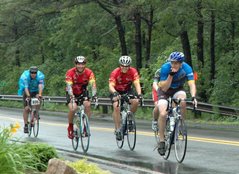Don't just exercise your legs. Do a little training for upper body strength. This will help avoid fatigue or stiffness in the arms and shoulders.
Mix up your training - add variety - distance, routes, speed, who you ride with......
Pedal circles - i.e. not just push on down stroke. This achieves a smoother smoother action and reduces overall fatigue. It will require practice. Use toe clips or "clipless" pedals to optimize each rotation of the crank.
Take a break when you need to. Don't overdo it - especially in the early part of your training. Even a short break of five minutes will revitalize you.
Use a mirror to see behind. This helps know what is coming up behind you and hence adds to your safety. Mirrors can be attached to the helmet or handlebars. Get into the habit of looking in your mirror &/or over your shoulder regularly and especially when changing direction or position on the road.
Be sure your bike is the correct size and that it is adjusted to fit your body. This is especially important for longer rides - you can get away with a not so good fit for just and hour or so. Correct set up will greatly help both your comfort and efficiency. Consult experienced riders if you are not sure.
Use a bicycle computer. They are inexpensive and help develop an understanding of your capabilities and keep track of your improvement. It is helpful to keep records in a log.
Frequency - you should ride no more than 6 days a week. You will need at least one day a week to recover.
ALWAYS WEAR A HELMET - every time you go out. Make sure it fits you properly and is in excellent condition - no damage, frayed straps, buckles/clips work correctly etc....
Subscribe to:
Post Comments (Atom)

No comments:
Post a Comment